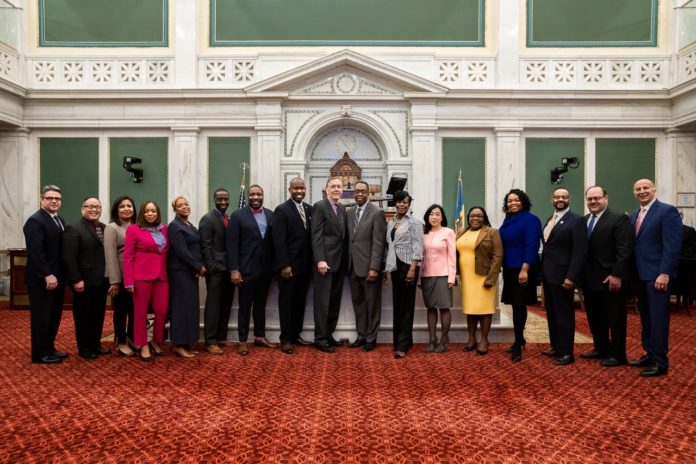The final redistricting map Philadelphians have been waiting for was released on Wednesday, January 26th at a public hearing convened by City Council. Federal and state level maps proposing new districts had been released in the previous weeks, based on different timelines required for gathering public input and finalizing those through votes in US Congress and the Pennsylvania state legislature. Initially, on Thursday, January 20th, City Council released a document listing the divisions in each proposed new district, but did not include a map of the boundaries. The map was made available at the time of the public hearing, and is available on the interactive mapping platform DistrictBuilder (a tool produced by software engineering and data analysis firm Azavea). Both the new proposed districts and the previously existing districts are available for analysis at this site.
This decade’s City Council redistricting process was widely considered to be relatively straightforward, compared to some of the negotiations that have taken place in Philadelphia’s history. In 2001, in particular, a highly contentious negotiation process within Council and Mayor Street’s office led to district boundaries that were considered to be egregiously gerrymandered – among the most gerrymandered municipal boundaries in the country, at the time. The process in 2011 was seen as rectifying the worst of the gerrymandering, creating districts with greater continuity and better representation of their communities. This year, the new map proposed by City Council contain only minor changes.
However, despite the absence of dramatic changes to the existing map, advocacy groups and community members did levy criticism of the process at the January 26th hearing. Some critics claimed the process did not provide enough opportunity for public awareness and involvement. Other locales across the state – such as Pittsburgh and Erie, for example – reportedly established advisory committees much earlier to promote public engagement throughout the process, soliciting public input to inform and guide maps’ creation. This is in contrast to Philadelphia’s approach of engaging city residents only after the map was already created behind closed doors. Others questioned the method of accounting for Philadelphians who are incarcerated, sometimes called “prison gerrymandering,” because these individuals are counted in the district where they are in prison, rather than in the home communities they came from and will return to upon their release. Finally, although advocates acknowledge that the proposed map reflects population growth and movement in Philadelphia over the last ten years, some expressed concern that these district boundaries will quickly become outdated. Ethnic and cultural groups continue to shift rapidly across the city. Questions have been raised regarding how the city will adapt over the course of the next decade, if it only takes a few years for the population to shift enough that the map no longer adequately represents communities.

These concerns are being voiced in the midst of an unusual time for redistricting. In addition to the ongoing impacts of the Covid-19 pandemic on the capacity and functioning of all organizations, the timeline for redistricting has not unfolded smoothly this time around. In 2001 and 2011, Census data was provided to City Council in May, and the deadline for finalizing the new map was in September. This year, preliminary Census results were not delivered to City Council until August, and even then, the data was not in a granular fashion that could be used to begin creating the map. Granular-level data was not provided until mid-September, pushing the 6-month deadline into the campaign season for the 2022 election – which includes a race for Governor, Lt. Governor, and other key elected positions.
With a deadline of February 12th to deliver a finalized and approved map, City Council is under two forms of pressure to finish and release the new districts: First, the districts must be defined before candidates can begin collecting signatures to get on the ballot for the upcoming primary election. Aspiring candidates have only three weeks – from February 15th to March 8th – to collect enough signatures to get on the ballot. The primary is scheduled to take place on May 17th, but March 8th is the deadline to file as a candidate. Naturally, candidates must collect signatures from within the district they hope to represent; therefore, they can’t begin their outreach to their constituents until they know their district boundaries. In addition to the time pressure, Council faces another looming consequence of any delays – the law requires City Council members to stop collecting their paychecks after February 12th if the process has not been concluded. They may resume collecting pay once the map has been finalized, but must go without pay for any period of time the process is delayed past the deadline. These factors create a particularly high-pressure situation this year. The stakes are high, and Philadelphians should be as engaged as possible to ensure fair political representation over the next ten years.







